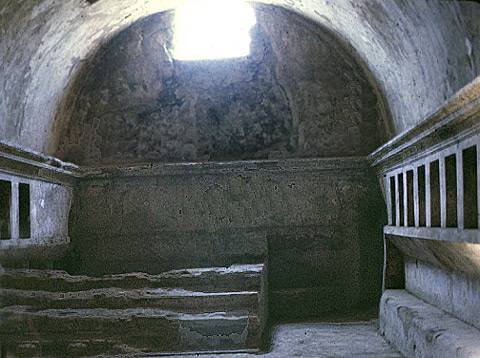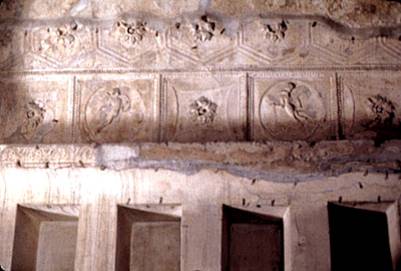|
|
 |
|
Baths & Bathing as an Ancient Roman |
|
written
by kjw2 / 09.13.2004 |
|
|
| |
Function |
| |
| |

|
| ~bmcmanusbaths.html > |
| Oil Flask and Strigils |
| A visitor to the baths would have carried an oil flask and strigils like this. They might also carry towels, bathing attire and perfume. |
| |
|
| |

|
| www.vroma.org/ ~bmcmanus/baths.html |
| Frigidarium and Women's Dressing Room |
| This room had two functions, it was the women's changing room and it functioned as the women's cold room (frigidarium) with a small cold pool in the other end. The men had separate and larger changing and cold rooms. |
| |
|
| |

|
| www.vroma.org/ ~bmcmanus/baths.html |
| A Dressing Room Niche |
| This niche at the Stabian Baths was used to store clothes in. You can see some traces of decorations that used to be on the walls. |
| |
|
| |

|
| www.vroma.org/ ~bmcmanus/baths.html |
| Grafito of Ship |
| A close up of a Grafito of a Ship scratched on a post between two niches in the dressing room. |
| |
|
Romans typically frequented the baths at around 2 in the afternoon (during the Roman 8th hour) after the workdeay ended at about noon and before dinner which was taken in late afternoon or early evening. Baths were loud and crowded. One description by Seneca, a philosopher who lived in an apartment above a public bath, describes “the assortment of sounds which are enough to make me hate my very powers of hearing” (Paoili 225). Seneca bitterly describes the sounds of straining weightlifters, pummeling masseuses, shouting scorekeepers, splashing swimmers, singing bathers, and the advertising cries of the armpit hair-plucker, and the wails of his customers. In spite of the noise and activity, the baths were a luxurious place to spend the afternoon. They were lavishly decorated, the walls, floors and ceilings covered in beautiful colored marble, mirrors and mosaics accented with bronze or silver faucets. The hot air circulating throughout the walls from the hypocaust would have made the walls pleasantly warm to the touch and the air was probably warm and well circulated. High ceilings and large windows would have given the baths a light and spacious feel. Hungry patrons could pickup a snack at any of the stands within and around the baths. They could be massaged by professional masseurs and sit and sweat in a sauna-like hot room, the laconicum. Since the bathing ritual took a long time, going from room to room, the baths were a place to socialize and meet friends to catch up on the latest gossip or discuss politics.
After arriving at the bath, a typical citizen would change clothes in the apodyterium, or changing room, storing their clothes in little niches or cubbies. Wealthier patrons would pay a slave to keep watch over their belongings, while poorer patrons could pay the attendant to keep an eye on them. There was probably usual bathing attire, though the nature and extent of this bathing attire is debated (see discussion on nudity in the baths in the last section of this report). It is known that they wore special sandals called sculponea with thick wooden soles to protect their feet from the heated floors. In general, after changing Romans were rubbed down with oil by a slave then they exercised in the palaestra. Exercise wasn’t supposed to be strenuous, rather they worked out only until they worked up a light sweat. Possible exercises included walking, running, reading aloud, mild weight lifting, wrestling and various ball games. There were lighter exercises which were deemed appropriate for women, such as rolling a hoop with a stick or swimming. After exercising they would scrape the dust and oil from their skin using a strigil, a curved metal instrument originally used by Greek athletes. After this, they would bathe, alternating temperatures as they alternated rooms. Romans weren't required to visit the rooms in any particular order, but the generally bathers would visit the hot room, the caldarium first. It contained a bath or a small pool of hot water, and the air was warm. Some caldariums had a labrium, a small waist high basin of cold water with which bathers could splash themselves. After the caldarium bathers could go to the warm room, the tepidarium, as a transition before the cold room. Bathers could finish off with a refreshing dip in the cold pool of the frigidarium. There were several other types of optional rooms found in some of the later and more elaborate baths. A solarium or heliocaminus, was a room with unglazed windows for sunbathing. The Stabian Baths contain a laconicum, a superheated sweat bath like a sauna. Other baths could contain a sudatorium which was similar to a laconicum, except it had humid instead of dry heat. There could be a room for anointing with oil, the unctorium, and gardens, libraries and lecture halls off the palaestra. Bathing ritual would change according to the trends and medical recommendations of the day and baths would remodel and evolve to fit consumer demands.
At the end, visitors would finish off their bathing experience by drying off with linen towels and being anointed with perfumes and oils. After bathing it was customary to go home and eat a long dinner, the main meal of the day. Baths functioned as a meeting place for guests before a dinner party (bathing after dinner usually did not occur, as Romans were fully aware of the potentially fatal combination of swimming and a full stomach). Some Roman writers complained that some people would even seek out dinner invitations at the baths by being obsequious, annoying, or even harassing. The Roman bathing establishment was a combination of a modern day spa, country club, community center, coffee shop and library. The bathing experience, as the Romans defined, it remains unequaled in American society today.
|
| |
|
| |
|
|
 |
|




